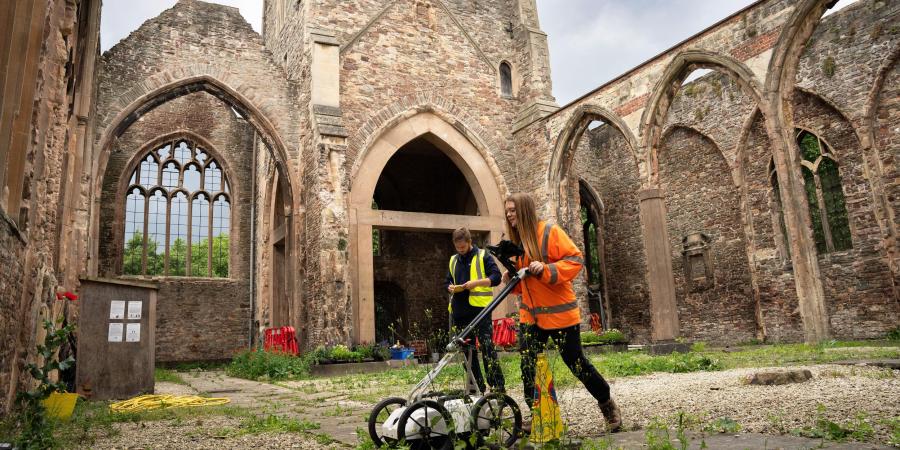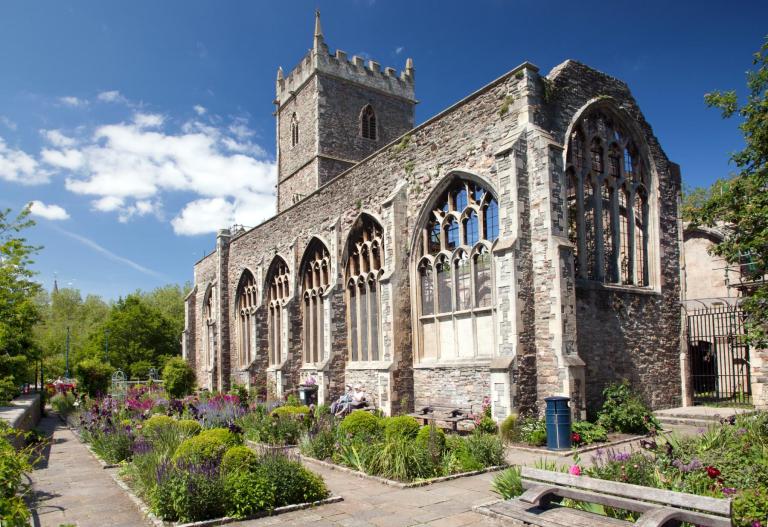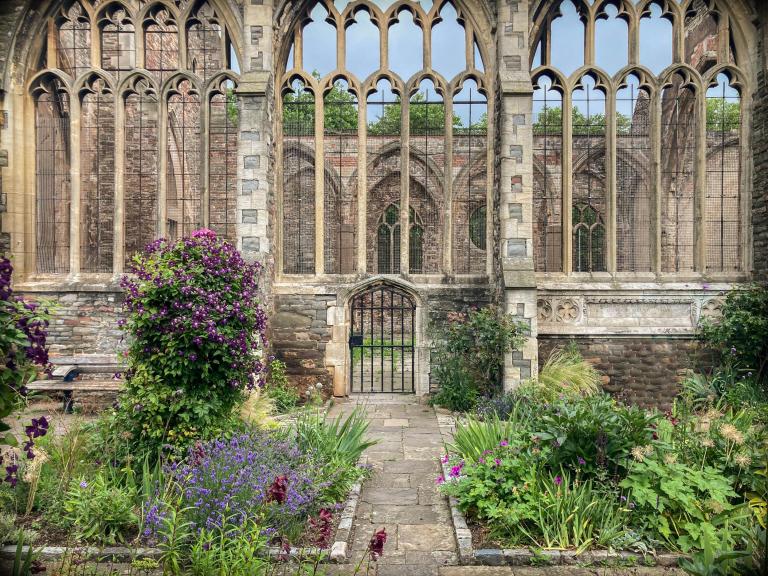By Cai Mason, Senior Fieldwork Archaeologist
A piece of Bristol: St Peter’s Church
In July 2022, Wessex Archaeology carried out an archaeological work in the ruined St Peter’s church, Castle Park, Bristol. This area, once a densely built-up commercial district in the oldest part of Bristol, was heavily bombed during World War II, leaving St Peter’s Church a gutted shell. The church was subsequently preserved in memory of Bristol’s Blitz victims.
In recent years the church’s exposed walls had begun to deteriorate, and the floor had started subsiding. Eventually, the building was closed to the public due to safety concerns. With the help of Historic England, Bristol City Council has recently repaired the walls, but the floor is in poor condition. The principal aim of the archaeological work, supported by The Pilgrim Trust, was to discover why the floor is subsiding.
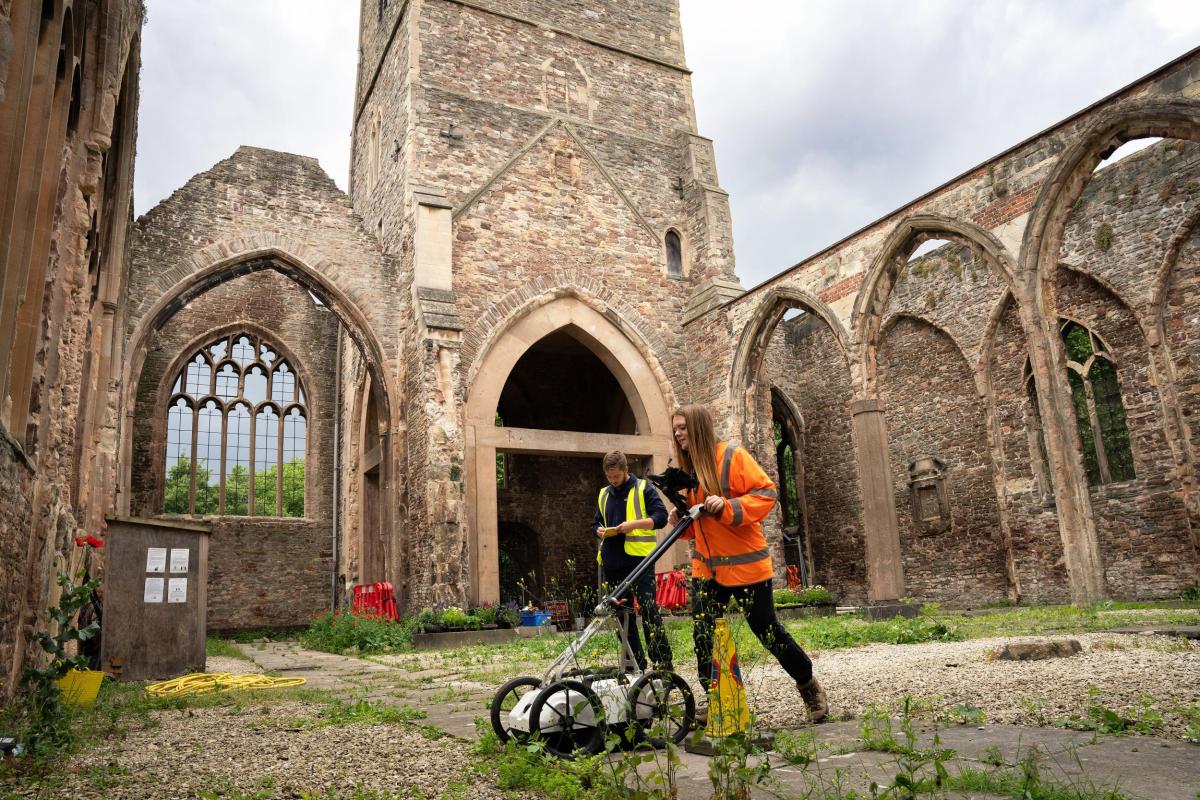
Above: Ground penetrating radar survey in St Peter’s Church.
What did we find?
The first stage of investigation involved Ground Penetrating Radar (GPR) survey. This revealed what appeared to be numerous earth-filled graves within the church, and other features that were interpreted as possible buried walls, including a curving feature which looked suspiciously like the apse of an earlier church.
The next stage of work entailed hand excavating four small trenches. Some late medieval foundations were found in the northernmost trench, but none were deep enough to confirm if the curving structure identified by the GPR survey was indeed part of an earlier church.
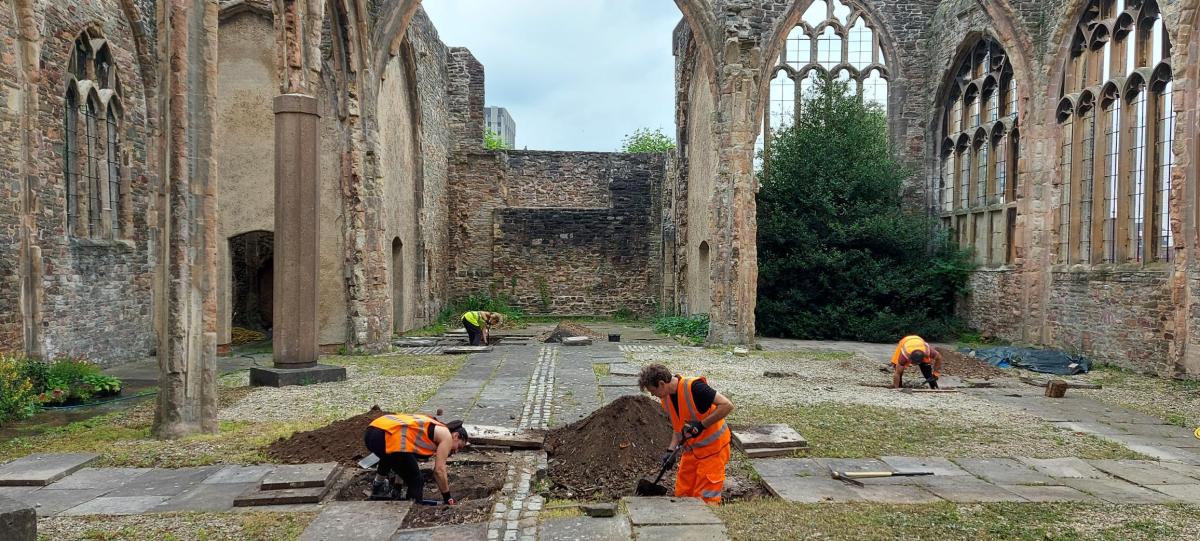
Above: Excavating trial trenches in St Peter’s Church.
Grave clearance: Solving the sinking floor mystery
Our main aim was to understand why the floor is sinking, which soon became clear. In all our trenches there were deep 18th- and early 19th-century brick-lined graves. It became apparent that all but one had been disturbed in the relatively recent past. Brick-lined graves are normally capped with large blocks of stone, but these were all missing. Instead, the grave shaft, which should have been a void with one or more coffins in the base, was infilled with soft soil and rubble containing broken pieces of church floor, demolition debris, and a smattering of medieval to modern finds, including 1960s pottery. This loose fill has been gradually settling, ultimately causing the floor to sink.
So why were the graves emptied? The reason for this can be found in the origins of Castle Park. Before World War II, Castle Park was one of Bristol’s main shopping districts. Castle Park was devastated during the Bristol Blitz, and, in the immediate post-war period, much of the area was levelled for use as carparks. Plans for comprehensive redevelopment were drawn up, including one that would have seen most of St Peter’s demolished, leaving only the tower standing, and it is probable that graves clearance took place ahead of this work. Yet the redevelopment never happened. Instead, the council created a city centre car park, with St Peter’s preserved as a memorial to Bristol Blitz victims.
Above: Fragment of carved drapery from the hip of a recumbent effigy with a dress. Note trailing sleeve with striped diagonal band.
A lost 17th century tomb
Among the soil and rubble, we uncovered a range of medieval and post-medieval stonework. The latter include three unusual carved pieces: one with carved drapery, and two pieces of cornice carved with grapevines on a red painted background. An identical cornice fragment resides in the stores of Bristol Museum and Art Gallery, listed as a fragment from an early 17th-century effigy tomb that once stood in the south aisle of St Peter’s.
Above: Cornice from the chest tomb carved with grape vines.
This monument, which dedicated to a female member of the Newton family, almost certainly Antholin Newton, comprised a chest tomb with an effigy of a woman, covered by a highly decorated canopy supported by Corinthian pilasters. The upper parts of the monument were decorated with coats-of-arms of the Newton and Clarke families.
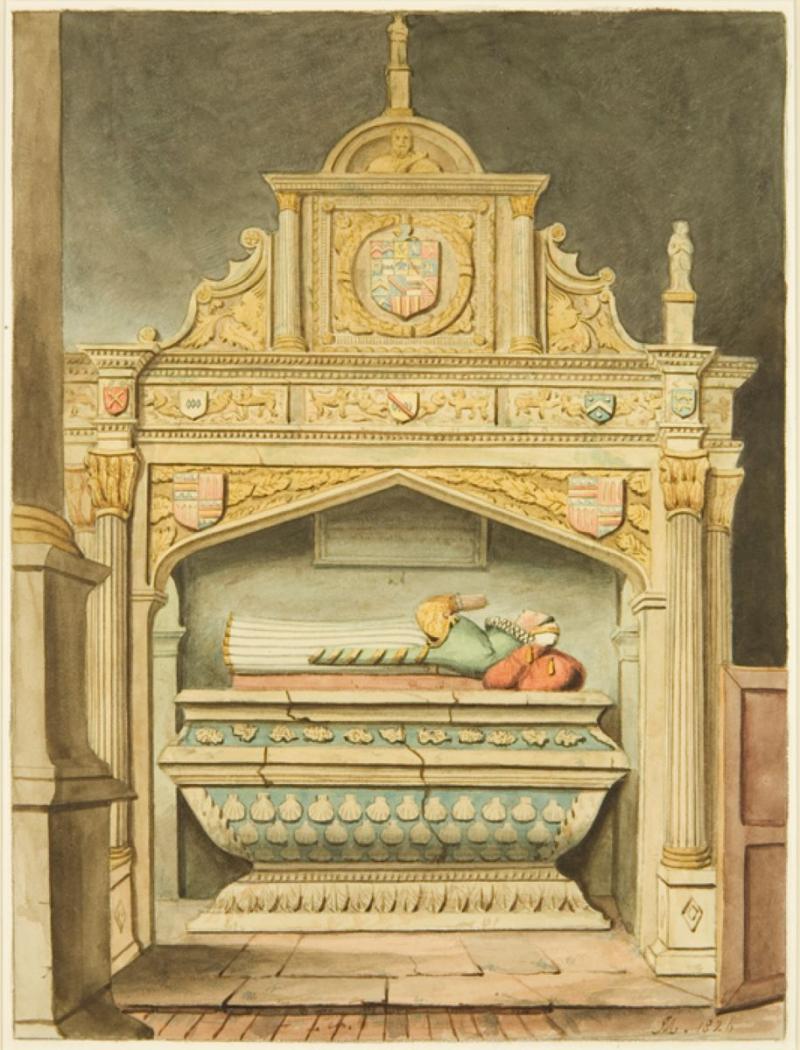
Above: Memorial to Antholin Newton, by J. Manning, Reproduced with permission of Bristol Museum and Art Gallery (ref. M2675). Note: although the chest tomb is shown as blue, records indicate that the monument was repainted in the early 20th century, hence the red background on the surviving fragment of cornice.
Who was Antholin Newton?
Antholin, (nee Clarke), was probably born in Wookey or Wells, Somerset, between the 1530s-40s. The Clarkes were a wealthy family of gentry status, many of whom worked as government clerks. Antholin’s grandfather, Thomas Clarke, was a diplomatic clerk serving Cardinal Wolsey, and later Secretaries of State Richard Pace and Thomas Cromwell. During Wolsey’s tenure as Bishop of Bath and Wells, Clarke was posted to Wells. Administering the bishop’s properties, he continued this role after his brother John Clarke was appointed bishop in 1523. As Cromwell’s servant during the Dissolution, Clarke profited from the suppression of the monasteries, and it was during this period that he amassed the wealth to purchase manors at Locking and Wookey. By the 1540s the Clarkes also had a near-monopoly on the local milling trade.
A woman of means
Antholin, along with her eight siblings, probably spent her childhood at the family home in the old bishop’s palace in Wookey. Her father Henry acquired further manors at Kingston and Blackford plus mansions in Wookey and Wells, and when he died in 1565, and the manors of Wookey and Blackford and lands in St Decumanus, Somerset, were split between Antholin and five of the younger siblings.
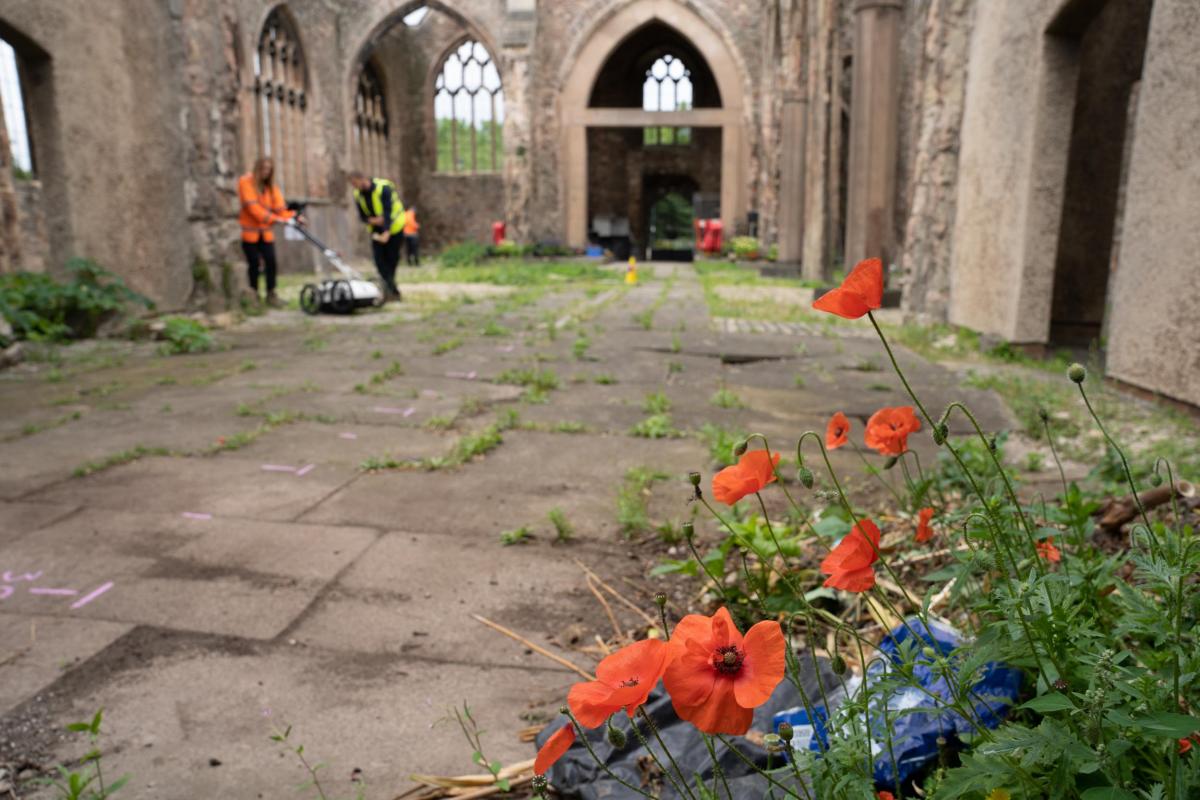
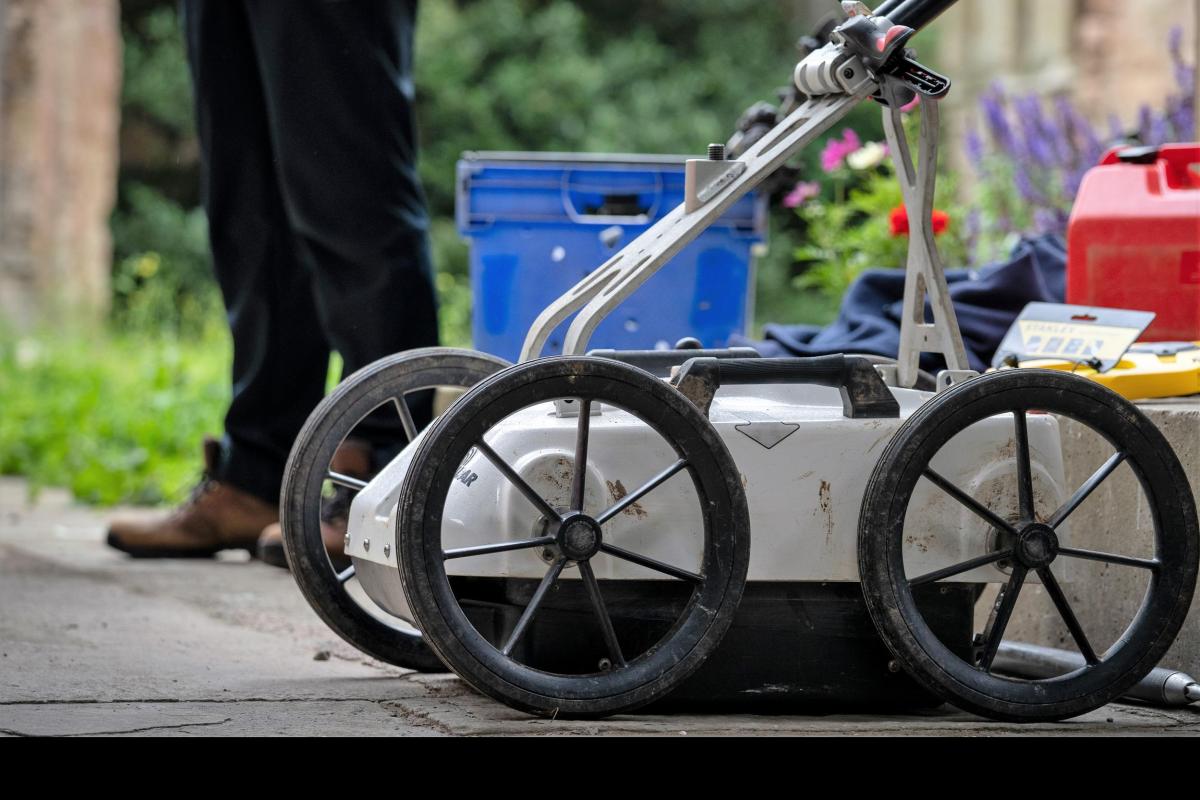
Above: Geophysical survey at St Peter’s Church
To the manor born?
Antholin married John Newton, the illegitimate son of Sir John Newton of East Harptree and Barrs Court. Another landed family, they lived between Barrs Court (now a public park in Bristol’s outer suburbs), and Eastwoods mansion, in East Harptree, Somerset. As an illegitimate child, John Newton is unlikely to have inherited a great fortune, and he and Antholin seem to have made their home in his brother Henry’s Great House, sometime after 1580. The Great House, later known as St Peter’s Hospital, was a late medieval mansion that opened onto St Peter’s churchyard.
John and Antholin’s only child, Frances, married her second cousin, Sir John Poyntz of Acton Court, but died young in 1599. Antholin and her husband both died a year or two later. So, who paid for the elaborate tomb? Her husband was already dead, and her son-in-law, Sir John Poyntz, was virtually bankrupt. It seems likely Antholin either funded her own memorial, or that her surviving siblings or late husband’s family paid for it.
Bristol’s rising classes
Antholin isn’t the only member of the Newton and Clarke families memorialised with such an elaborate effigy tomb. Other surviving examples, in Bristol Cathedral and the parish churches of Wookey and East Harptree, date from the late 16th - early 17th centuries. At this time, landed gentry and prosperous merchants were beginning to rival the established nobility in wealth and power. Throughout the late medieval - early post-medieval periods, effigy memorials were commemorated nobles and high clergy, and the choice of this form, placed in prominent locations in the communities where they lived, acted as a deliberate statement of the Newton and Clarke families’ newfound wealth and status.
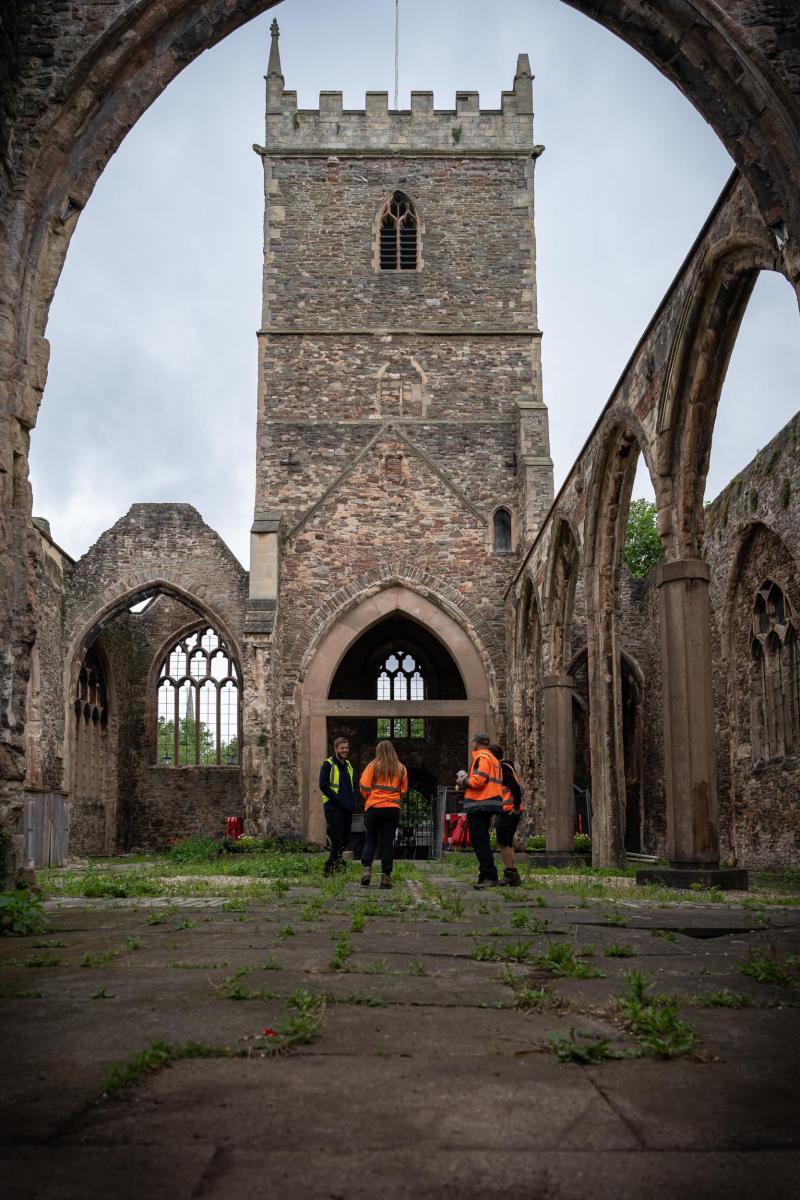
Above: View of the full scale of St Peter’s church
But what happened to the monument?
Despite being gutted by fire, historic photographs evidence the Newton memorial’s relatively intact survival following the Blitz – so what happened to it?
After the War, St Peter’s was left as a roofless shell, leaving surviving memorials exposed to wind, rain, frost, and possibly the attentions of vandals playing amongst the overgrown bombsites. An adjacent memorial to the sugar merchant Robert Aldworth was dismantled in 1958, but Newton’s memorial was left standing for another decade. It was finally dismantled in 1969, probably as part of cemetery clearance. A few pieces were placed into storage at St Nicholas’ Church Museum (later transferred to the Bristol Museum and Art Gallery stores), but most of the memorial, including the elaborate canopy and effigy seem to have disappeared.
So where did the rest of the monument go? The unexpected discovery of the fragments in our trenches confirms that parts of the demolished monument are still hidden safely, but out of sight, under the floor of St Peter’s!
